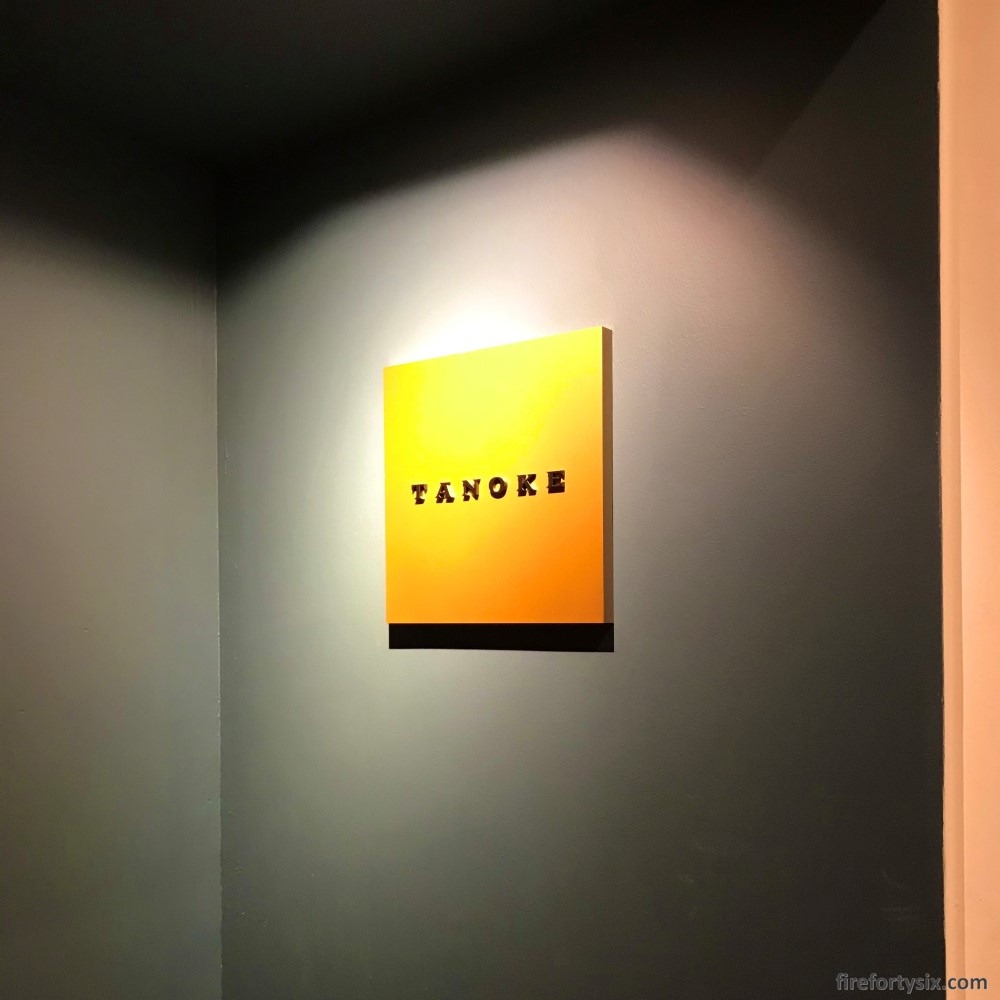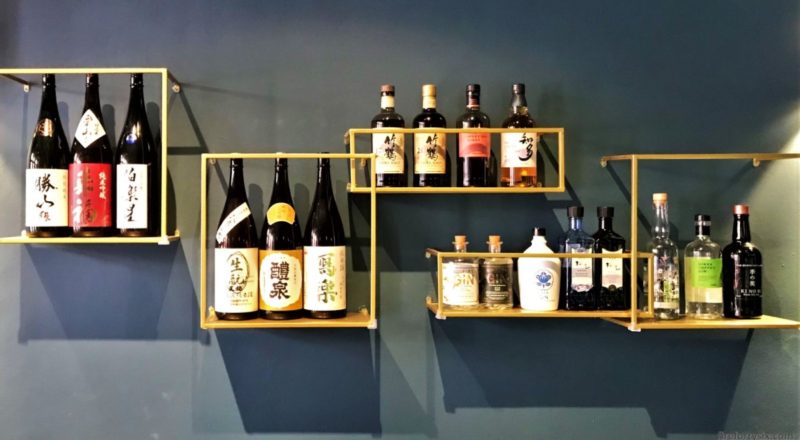After our value-for-money lunch at Beach Road Kitchen, we had high expectations for our second stop in this year’s Restaurant Week — Tanoke, on the famous Purvis Street restaurant row.
They don’t have a large outside-facing signboard, so they’re not easy to spot, but if you look up to the second floor above Samundar, you’ll see three red windows. And that’s where Tanoke is located.

As you approach, you’ll see their relatively inconspicuous signboard pointing you to the second floor, through a small door and up a narrow flight of stairs.


Turn left and you’ll find the main entrance to the restaurant, with a minimalist feature wall lit with warm downcast lighting.

The main dining hall and bar is straight ahead from there, and to your right is a small flight of stairs that leads up to their mezzanine level which has a large communal table and two smaller couple tables. There was a family having their meal at the communal table and we didn’t manage to get a shot of the large table, but it comfortably seated eight adults and children.
I assume that once pandemic restrictions are lifted, they will be able to join all the tables and take bookings of up to 12 people for a meal in a cosy dining setting. The mezzanine has outside-facing windows that let natural sunlight in and provides a birds-eye view of the dining hall downstairs.




Our assigned table was in the main dining hall downstairs, which had a dominant deep-blue and red theme. While the large windows let in a lot of light, the dark hues gave the impression of a sake bar/izakaya kind of place that would cater mainly for a post-dinner crowd.

The main attraction of Tanoke is the good selection of sake and other Japanese spirits they serve. I noticed two of our favourite bottles featured in their bar display — Nikka Taketsuru 17y whiskey from Hokkaido and Ki No Bi gin from Kyoto, triggering fond memories of our past trips.

The six bottles of sake on display were only a small sample, because once you turn around, you’re greeted with a wall of chillers packed with sake from all over Japan. It’s not a terribly large collection, but it is impressive and not a common sight in Singapore.


The first thing I did was to try and find my favourite sake, the legendary Juyondai (十四代) from Yamagata prefecture. I’ve had it several times during my meals at Ajisen (no, not the ramen chain), Hitsumabushi Bincho and Torimikura in Tokyo, but have never seen it served in Singapore. Unfortunately, Tanoke was no exception.
What I found interesting though was how they classified and presented their sake selection by regions and prefectures, not just in their menu but also physically in their refrigerators.
Conspicuously absent though were sakes from Hokkaido, even though the outline of the island was included in the map.





Because we had booked the lunch under Restaurant Week, a customised menu was placed on our tables. However, after some careful comparison, it turned out to be nearly identical (in both choices and prices) to their usual lunch set menu, except for the complimentary green tea.




The Wife found their ala carte menu very interesting, because the combination of colours against the blue wall reminded her of her old school uniform, and like what it says on her favourite recycling bag: “Once a Cedarian, always a Cedarian.”


Their digital lunch, dinner and brunch menus (in PDF format) are available for download from their website, but I’ve included them here for easy access. You can tell that their focus is on their sake selection just by the percentage of real estate it takes up. Note that their menus may change over time and these were downloaded in April 2021.
Our meal started with the complimentary green tea, a simple and light salad dressed and a bowl of miso soup. The tea came in a tea bag and was a notch better than the usual stuff served in Japanese family restaurants.
The salad was dressed in a tangy ponzu sauce and was cold and refreshing, which contrasted with the warm and rich soup made with aka miso and filled with wakame seaweed and soft tofu cube-lets. And even though it didn’t contain any, the dashi had the rich taste of asari clams.


It’s not something that we do often, but we decided to treat ourselves to some day drinking and ordered a glass of sake each.
The Wife chose the Nihonzakari Yuzu Shu, an inevitable outcome given her unfortunate and incurable yuzu addiction. It was good, but not as good as her favourite from Umenoyado or her second favourite from Choya.
The Raifuku Junmai Ginjo Aiyama from the Central Ibaraki prefecture was my choice, and it came with these tasting notes: “Medium sweet. Intense tropical aromas of ripe banana, lychee, rose petals and cotton candy. Silky, extremely well-balanced.”
I couldn’t taste the banana or cotton candy, but the hints of lychee and rose were discernable and it was definitely medium sweet.
I really liked the Raifuku and asked our waiter to show us the bottle, so that I could search for it online. It was one of the six that were featured in the bar counter display with the 来福 kanji prominently displayed in gold lettering on the red label.


And since we were day drinking, we had to have some snacks to go with the alcohol and ordered the Gobo Age and Sansho Pepper Tori Karaage.
The gobo came deep-fried and in delicately thin strips that must have been sliced on a mandolin. It was dusted with sansho pepper and accompanied by a blob of sweet mayo (most likely Kewpie?). We were expecting thicker chunks so that we could enjoy the pleasantly earthy taste of burdock root, but these weren’t too bad.
The karaage, on the other hand, was near perfect. Crispy on the outside, soft and juicy on the inside, like how really good karaage should be.
We didn’t manage to finish everything before our mains arrived and they sat for a while before we got to them again, but by then, they had dried out somewhat. So, if you ever order the karaage, remember to eat them immediately for maximum enjoyment.


The Hamachi and Tuna Chirashi Bowl was listed as a Chef’s Special and only available during lunch.
Half of the rice bowl was topped with slices of hamachi, and the other half with equally-sized dices of tuna, cucumber and egg. Thin strips of nori and a pretty shiso leaf sat on top of the toppings, together with a spoonful of ikura and a blob of real wasabi.
It was a very good chirashi don, made with really fresh hamachi and tuna. The contrasting textures of the cucumber, tuna and egg cubes made each bite interesting, and was accentuated by the occasional burst of saltiness from the ikura.
On hindsight, I should have gone with the S$8 top-up for more ikura goodness.


The Wife’s Australian Striploin Rice Bowl was topped with generous strips of smoky medium rare striploin, a gooey onsen egg, thin slices of cucumber, garlic chips and truffle shoyu.
This was clearly not your typical gyudon from Yoshinoya, Sukiya or Matsuya. Every bite was a flavour bomb and we could only wonder how the upsized version (+S$30) using A4 Kyushu tenderloin would have tasted.
Their dinner menu features a sharing 3-Cut Wagyu Platter (S$128) cooked on their shichirin binchotan grill featuring 80gm of A5 Tochigi ribeye, 50gm A4 Kyushu tenderloin and 80gm MB7 Australian striploin. We now know where to go when we want to splurge on some good beef.


The set lunch ended on a sweet and creamy note with some decent matcha ice cream. Our waiter, seeing that we had finished our glasses of sake, suggested another round each.
I was sorely tempted, especially since they offered many choices by the glass (90ml) and in 180ml or 300ml carafes, in addition to their numerous 720ml bottles. But I managed to restrain myself.
Before we left, I asked our waiter for the meaning behind the restaurant’s name. Turns out it’s a portmanteau (which is just a fancy word for mash-up) of three Japanese words: TAberu (to eat), NOmu (to drink) and SaKE (well, sake).
So, if you’re missing the taste of Japan and can’t hop on a plane to get there, Tanoke is probably the next best thing.
Note: This post contains affiliate links. If you use these links to buy something, I may earn a commission. Thanks.
